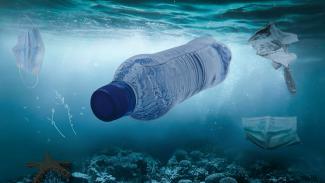Above: NETL tool is being used to monitor the Great Pacific Garbage Patch for cleanup activities.
A digital tool developed by NETL that helps examine ocean currents and wind patterns to predict where oil and other particles in the ocean are likely to travel in the event of an oil spill is being used for a range of non-energy related uses - like keeping track of the Great Pacific Garbage Patch for cleanup activities.
NETL’s Kelly Rose, Ph.D. explained that the Climatological and Instantaneous Isolation and Attraction Model (CIIAM) was developed within NETL’s Advanced Offshore Research portfolio (AOR) as one of several projects initiated because of lessons learned following the 2010 Deepwater Horizon oil spill in the Gulf of Mexico. That event highlighted the need for improved models, data, and tools to prevent future events, and improve response preparedness.
CIIAM can be accessed through the Lab’s Energy Data Exchange (EDX), along with offshore spill prevention, carbon management and other predictive tools. EDX supports private collaborations for ongoing research efforts and technology transfer of DOE research products like CIIAM.
“CIIAM leverages scientific expertise along with big data science, machine learning, and computing to forecast hazards and identify risks that contribute to offshore spills,” she said. “It also provides rapid predictions of the transport of surface spills to aid response planning and containment. CIIAM uses a high fidelity approach that demonstrates high impact and value for applications lie cleaning up our oceans.”
Monitoring the Great Pacific Garbage Patch is a prime example. The patch is a collection of spinning marine debris in the North Pacific Ocean. It spans waters from the West Coast of North America to Japan. The spinning patches are linked together by the North Pacific Subtropical Convergence Zone where warm water from the South Pacific merges with cooler water from the Arctic. It serves as a highway that moves the debris around.
The National Oceanic and Atmospheric Administration (NOAA) determined that the garbage patch is a vortex of plastic waste and debris broken down into small particles in the ocean.
According to a study conducted in collaboration with Deloitte, yearly economic costs due to marine plastic pollution are estimated to be between $6-19 billion. The costs stem from the plastic’s impact on tourism, fisheries and aquaculture, and governmental cleanup efforts. Plastic pollution also carries toxic pollutants into the food chain.
The Ocean Cleanup, a Rotterdam-based non-profit organization, is developing technologies to rid the world’s ocean of plastic. It recognized CIIAM as a valuable tool in forecasting the movements of the debris so that its collection vessels can effectively conduct collection operations.
According to the Ocean Cleanup website, “The circulating currents in the garbage patch move the plastic around, creating natural ever-shifting hotspots of higher concentration. With the help of computational modeling, we predict where these hotspots are and place the cleanup systems in these areas.”
That’s where CIIAM comes in. CIIAM provides a way to calculate climatological changes in ocean currents or atmospheric patterns, and short terms attractors that identify confluence of material moving with fluids. CIIAM uses advanced mathematical tools and oceanographic information to efficiently extract ocean and atmospheric pathways from large datasets, providing likely transport behavior of oil, red tides, sediment, icebergs, and more. It can also be used to evaluate ocean current-induced stresses that could impact infrastructure such as oil rigs or platforms.
Ocean Cleanup uses CIIAM and other tools in its efforts to eliminate plastics in the ocean. According to Ocean Cleanup, “To effectively clean an area of such magnitude, a calculated and energy-efficient solution is required. With a relative speed difference maintained between the cleanup system and the plastic, we can concentrate the plastic for extraction. Active steering and computer modeling enable us to target plastic hotspots—areas of higher concentration—to improve efficiency.”
CIIAM is being used around the world for a growing number of other non-energy purposes in:
- The Mediterranean and Iberian Atlantic by Spain’s Federal Instituto de Ciencias del Mar to investigate oceanic plastic pollution, oil spills, forensic work related to crimes, and boating accidents.
- The North Sea by the U.K. National Oceanography Center to understand how transport of larvae might change with a changing climate.
- India by the National Institute of Oceanography to understand the likely outcome of oil spills.
- The Caribbean by the Mexican National University to understand the pathways and transport barriers that induce severe Sargassum inundations affecting the tourist region between Cancun and Tulum in Quintana Roo, Mexico.
- Mexico by the Mexican National University to understand previously unknown circulation patterns with implications for the fisheries and marine ecology of the western Campeche Bank in the Gulf of Mexico.
- Brazil to understand pathways influencing the generic movement of larvae and oil.
- The Red Sea, a region renowned for its coral reefs and marine diversity, by the Modeling and Prediction Group at the King Abdullah University of Science and Technology, to understand the dispersal of larvae.
Rodrigo Duran, Ph.D. an NETL applied mathematics and oceanography researcher, developed CIIAM with researchers Francisco Beron-Vera Ph.D. and Josefina Olascoaga Ph.D. from the University of Miami.
The objective of NETL’s Advanced Offshore Research portfolio is to build scientific understanding and assessment tools to prevent deleterious events. The program is focused on offshore spill prevention, recognizing that the socio-economic and environmental impacts from spills are far more costly than ensuring safe, environmentally responsible development of offshore resources. The portfolio blends laboratory studies with field and advanced computational modeling to better prepare, predict and prevent costs and impacts associated with offshore energy activities.
NETL is a U.S. Department of Energy national laboratory that drives innovation and delivers technological solutions for an environmentally sustainable and prosperous energy future. By leveraging its world-class talent and research facilities, NETL is ensuring affordable, abundant and reliable energy that drives a robust economy and national security, while developing technologies to manage carbon across the full life cycle, enabling environmental sustainability for all Americans.




